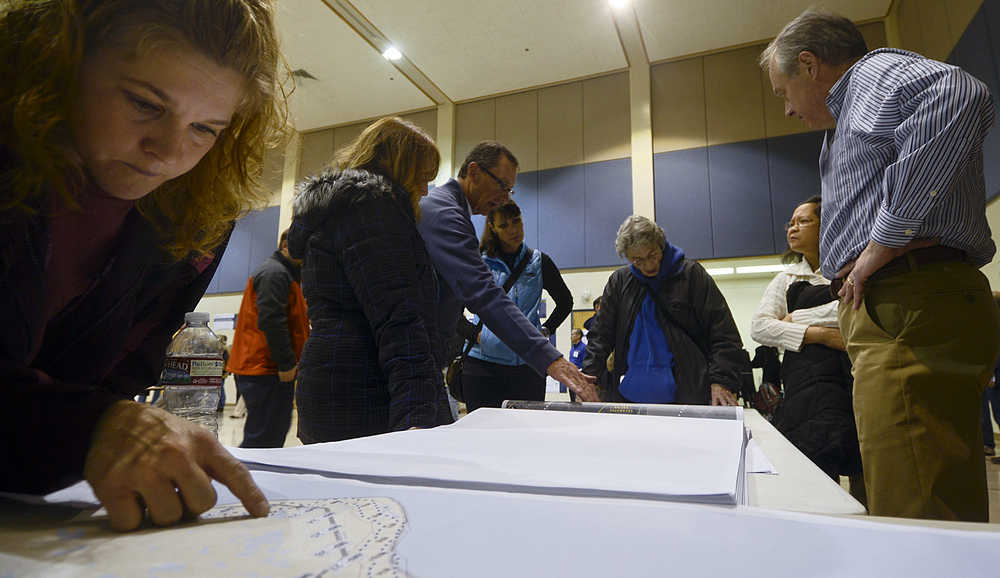Very few things seemed as interesting to the crowd as finding bird’s-eye-views of the homes in Nikiski in the two oversized map-books on a table near the back of room Tuesday in the Nikiski Middle-High School cafeteria.
More than 115 people signed in to the Alaska LNG project open house, the first of 12 scheduled across the state, as organizers share information about the multi-billion dollar natural gas development that would pipe gas from the North Slope and Prudhoe Bay to the Kenai Peninsula.
Katrina Nelson patiently waited at the crowded map table, glancing over shoulders and moving from one end to the other, her two children dutifully tagging along behind.
“I want to know if my house is in the study area,” she said, pointing to a dotted lining marking a 2,000 foot-wide corridor running down into Nikiski. “It looks like it’s out of the scoping zone. I didn’t realize the pipeline was going to go down the coast like that.”
John Swanson, pipeline executive manager, stood near the table answering questions for the throngs of people curious to see what exactly Alaska LNG has planned for the Nikiski-area.
In all reality, the pipeline route is far from set. The project is in the pre-front-engineering and design, or pre-FEED phase, which it expects to complete in late 2015 or early 2016. Part of that phase involves extensive scoping work as project organizers — ExxonMobil, ConocoPhillips, BP, TransCanada and the state of Alaska — try to determine the best way to build what could become one of the world’s largest natural gas development projects.
The 42-inch-diameter pipeline, built to carry 3-3.5 billion cubic feet of natural gas per day, is currently mapped to take one of two routes to Nikiski. One runs south from the North Slope until it reaches the Anchorage area and hops the Susitna River, running down the west side of the Cook Inlet to a spot between Beluga and Tyonek before crossing the inlet to Nikiski. The other potential route crosses to the east side of the Cook Inlet sooner and runs along the coast toward Nikiski.
“This is actually slightly shorter,” Swanson said, pointing to the route that route that crosses the Susitna River. “It’s a little bit more preferred, but the further you get out there, it’s very remote. Access is more of an issue.”
The other route involves much more private land and negotiations with owners.
“We’re studying all of that,” Swanson said. “You’d like it to be more remote, but there’s just a lot of trade-offs.”
While the company is studying a 2,000 foot-wide corridor for the approximately 800-mile pipeline, the actual right-of-way will be much narrower, Swanson said.
“About 50 feet,” he said.
In addition, most of it will be located underground, minimizing its visual impact to the surrounding landscape.
“There’s a few river crossings and everything, where it will be above-ground. But, generally, it’ll be buried around here,” he said, pointing to the Cook Inlet on one of several maps taped to the walls at the high school. “Maybe we’ll keep it above ground in the North Slope area,” he said.
The three-hour meeting generated a lot of discussion and groups stood in small clusters around the room well into the evening.
Some, like Sen. Peter Micciche, R-Soldotna, posed for photos with the project diagrams, or, like Rep. Mike Chenault, R-Nikiski, answered questions from community members. Others, like the group of Federal Energy Regulatory Commission, or FERC, members, passed out information on the agency’s role in project permitting. Several dozen Alaska LNG representatives circled the room, answering questions and handing out white papers, maps and trinkets or directing children to a central table covered in coloring pages and crayons.
The FERC officials will attend each meeting with Alaska LNG as the organization prepares an environmental impact statement for the project. The federal agency’s approval will be required to construct and operate the gas treatment plant at the north slope, the 800-mile pipeline, and a gas liquefaction plant and LNG shipping terminal in Nikiski.
Swanson said most of the questions he heard from residents were about safety.
“They’re concerned about what will happen when construction comes through,” he said.
Swanson said he had been building pipelines for most of his career and had just returned from doing similar work in Australia. The public scoping meetings can be a helpful part of the project-planning process, he said, especially when it comes to quelling rumors.
“We were in a cafe over here this afternoon for a couple of hours … (someone) came over and said ‘I hear you guys are buying up people’s property and you’re only paying 10 percent.’ I said ‘No, that’s not true. This is a free economy.’ What this helps do is, they can hear it from somebody who’s got the (Alaska LNG) tag on, who can say, this is how it works.”
The companies have estimated a cost of between $45-65 billion for the project for the plant which would provide gas for Alaskans and foreign buyers.
Swanson said a project of the size of the Alaska LNG proposal needed residents to be on-board.
“These are huge land-use projects,” he said. “The land has value to the landowners and we’re guests on their property and we have to respect that. We have to understand that we’re going to put something through there and it’s not going to eliminate, but it’s going to alter how they derive their value, their income from the land. That’s got to be compensated.”
Reach Rashah McChesney at Rashah.mcchesney@peninsulaclarion.com.

